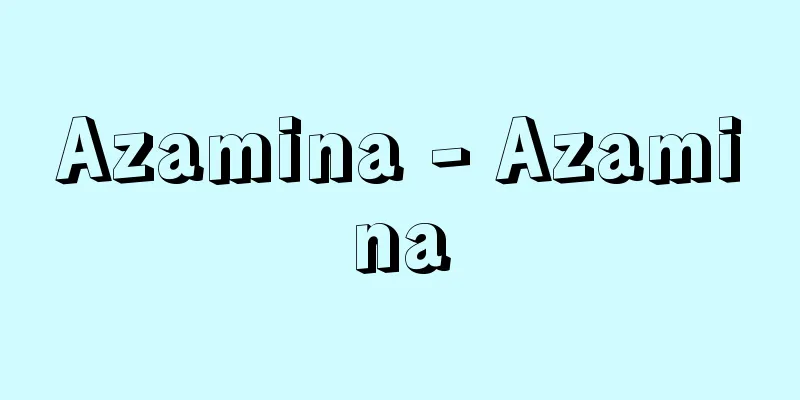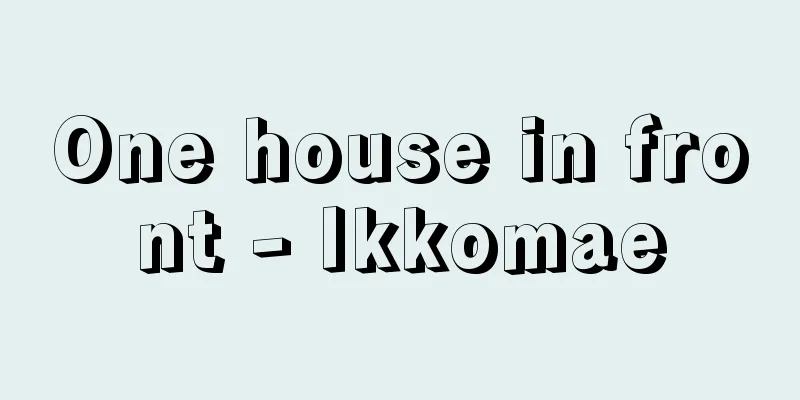Box - Hako

|
It is a container for storing things, and the Chinese characters �, 篋, 匣, 箱, 匱, and 箱 are also used as synonyms. They are extremely diverse in terms of material, shape, and use, and range from practical items to decorative items. Basically, they consist of a lid and a body. The pronunciation of the word hako (hako) can be found in documents from the Shosoin Repository from the Nara period. [Goka loyal retainer] BoxIn ancient times, boxes were used to store supernatural and mystical things, or important things that should not be shown to others. For this reason, standardized and decorated boxes were made. In the past, the main types of boxes were blue boxes made by weaving bamboo strips, bark and cores of trees and grasses, and vines, willow boxes, and kudzu boxes, as well as turned items made by hollowing out the insides of trees on a potter's wheel, and curved items made by bending thin cypress boards. Eventually, joinery, which involves joining wooden boards together, became the mainstream technique for box making. In the meantime, techniques such as lacquer leather, which uses animal leather as a base, and plating copper sheets were introduced from China and Korea. Base boxes were also made by pasting together pieces of paper and cloth and applying lacquer to them. Their shapes also varied widely depending on the contents, including rectangular, square, polygonal, and circular. The structure of the shape was classified by the type of lid, which included a cap lid, an inro lid (also called an aikuchi-zukuri), a lattice lid, and a sashi lid. The base type also included a flat bottom, a raised bottom, a daisashi lid, and a tripod lid. Looking at the external features, during the Nara period, when there was strong influence from the continent, linear external contours such as a beveled edge on the top of the lid and cut corners on the sides appeared, while during the Heian period, when there was a trend towards Japanese style, the top of the lid rose, the center of the body bulged, and the corners were rounded or indented, tending to curve in a way that gave a softer, warmer look. In terms of the types of boxes, Shosoin has mirror boxes, crown boxes, sugoroku boxes, kesa boxes, document boxes, incense boxes, prayer beads boxes, etc. Also, the Engishiki lists futon boxes, clothing boxes, sword cord boxes, hire boxes, takin boxes, comb boxes, and knife boxes, while the Ruiju Zoyosho contains illustrations of pillow boxes, incense jar boxes, medicine boxes, and miscellaneous paper boxes placed on shelves. The book also illustrates the contents of hand boxes, which were particularly important to aristocratic women at the time and contained items necessary for culture and beauty. A representative example is the Katawaguruma Raden Makie Hand Box (National Treasure, Tokyo National Museum). Boxes in particular were used to store items necessary for a woman's life, and when beautifully decorated, they became items to bring to weddings. [Goka loyal retainer] boxSince "hako" has the same origin as the Korean word pakoni (box), it is thought to have been introduced from the continent. In ancient times, it was believed that boxes could contain souls and the power to make people happy. An example of this is the Tamatebako in the tale of Urashima Taro, where the "tama" represents the soul. This shows that people at the time viewed boxes as extremely valuable and mysterious. Willow boxes, which are still considered sacred treasures at Ise Shrine, are made by connecting thin willow branches with thread, but this shows the difficulty of making boxes in ancient times. A child's wooden coffin from the Yayoi period Ama ruins in Takagaki-cho, Takatsuki City, Osaka Prefecture, was discovered, and a stone coffin from the late Kofun period shows that basic techniques for box making, such as oiretsugiki (attaching joints), tsutsumiuchitsuketsugi (attaching joints with small holes), and koanatsugi (attaching joints with small holes) were already in use at that time. However, relics date back to the Nara period. Many boxes remain, especially in the Shosoin Repository. There are practical boxes and decorative boxes, and the practical ones are often made of plain wood such as cedar or zelkova, or simply painted with transparent lacquer. There are small boxes to chests, but boxes of this type have basically remained unchanged until recently. Many of the decorative boxes are presumably imported from the continent, and are extremely sophisticated in terms of both technology and design. Many of them are for storing personal items, such as mirror boxes, jade belt boxes, sutra boxes, and booklets, and are made of fine woods such as rosewood, white sandalwood, and aloeswood, and are decorated with gold and silver color paintings or mitsuda paintings, mother-of-pearl inlay and wood paintings, and tortoiseshell and ivory. The shapes are also varied, ranging from square to circular, polygonal, and flower-shaped. In the Heian period, boxes decorated with makie (lacquer lacquer work) were developed, which became the epitome of Japanese aristocratic furnishings and continued into the early modern period. Among these were developed boxes for storing cosmetics, comb boxes, chests for storing clothing, wide-lidded boxes for placing gifts such as clothing, shoulder boxes for storing clothing and carried on a pole, crown boxes, writing boxes and letter boxes for storing paper, booklets or letters, inkstone boxes, and tiered boxes, food baskets and inkstone lids for storing food. Many boxes also developed for religious purposes. In addition to sutra boxes and kesa boxes, there are also distinctive boxes such as the precept box for storing the precepts during the esoteric Buddhism kanjo (a ritual for receiving precepts), and the sitting box for storing sermons and placing them on a side desk. The word "box" is sometimes used in a specific sense, such as a toilet, a shamisen box, a steam locomotive or train car, or the hut of a oxcart, but "ohako" can also refer to a special art or craft. [Kazuko Koizumi] ©Katsuya Nishikawa "> Names of the parts of the hand box ©Shogakukan "> Shape and structure of the box lid ©Katsuya Nishikawa "> Main types of box lids Korin style. Tools (bottom photo) are, from left to right, a water dropper, an inkstone, and a small knife. Edo period (19th century). 25.1 x 23.5 cm. Courtesy of the Metropolitan Museum of Art . "Woodcutter's Maki-e Inkstone Box" Edo period (18th century) Height 27 x Width 22.5 x Depth 21 cm. Collection of the Metropolitan Museum of Art . "Who's Sleeve Makie Jubako" Source: Shogakukan Encyclopedia Nipponica About Encyclopedia Nipponica Information | Legend |
|
物を収納する容器で、筥、、篋、匣、筐、匱、函という漢字も同意語として使用する。素材、形、用途などからみて多種多様であり、実用品から装飾品に至るまでその範囲は非常に広い。基本的には、蓋(ふた)と身から成り立っている。はこ(波古)と音したのは、奈良時代の正倉院文書にある。 [郷家忠臣] 筥古代の筥に収納するものは、古くは超自然的で神秘的な存在や、人に見せてはならない重要なものを込めた。そのために装飾を施して、定型化した筥がつくられた。古くは、竹のひご、木・草の皮や芯(しん)、蔓(つる)などを編んでつくった藍胎(らんたい)、柳箱(やないばこ)、葛箱(つづらばこ)など、また木の内部をろくろでくりぬいた挽物(ひきもの)、薄い檜(ひのき)板を曲げてつくる曲物(まげもの)がおもなものであったが、やがて木板を接合してつくる指物(さしもの)が箱製作の技術の主流となった。その間にあって、動物の皮革を素地とする漆皮(しっぴ)や、銅板にめっきする技術も中国、朝鮮から伝来した。また紙や布帛(ふはく)をそれぞれ貼(は)り合わせ、漆を塗ってつくる素地も行われた。それらの形態も長方、正方、多角、円と内容品によって多種にわたった。形の構造は蓋(ふた)の形態によって種別され、かぶせ蓋、印籠(いんろう)蓋(合口造(あいくちつくり)ともいう)、桟(さん)蓋、挿(さし)蓋などがある。また底の形式には平底、上げ底、さらに台指(だいさし)、三脚付きがある。また外形上の特徴をみると、大陸からの影響が強かった奈良時代には、蓋の上面の縁を斜面にとった切面取(きりめんと)り、側面の縁を切った隅切(すみきり)などの直線的な外輪郭が現れ、国風化のみられる平安時代には蓋の甲面が盛り上がり、胴の中央部が張り、それぞれの角が丸くなったり、入り込んだりするように柔らかみと温かみのある曲線化の傾向に変化している。 筥の種類をみると、正倉院には鏡箱、冠笥(こうぶりはこ)、双六(すごろく)箱、袈裟(けさ)箱、書類入れ箱、香箱、念珠(ねんじゅ)箱などがある。また『延喜式(えんぎしき)』には衾(ふすま)筥、衣(きぬ)筥、剣緒(つるぎのお)筥、巾(ひれ)筥、唾巾(たきん)筥、櫛(くし)筥、刀子(とうす)筥などが記され、『類聚雑要抄(るいじゅうぞうようしょう)』に枕(まくら)筥、香壺(こうこ)筥、薬筥、雑紙(ぞうし)筥などが棚に置かれている図が記されている。とくに当時の貴族の女性の座右にあって、教養と美容のための必要品を収納した手筥(てばこ)も内容品とともに図解してある。代表的遺品に、片輪車螺鈿蒔絵(かたわぐるまらでんまきえ)手箱(国宝、東京国立博物館)がある。とくに筥は女性の生活に必要な道具を収めるものとして、その装飾を華麗に施して婚礼にもつべき道具となった。 [郷家忠臣] 箱「はこ」は朝鮮語のpakoni(筐)と同じ起源のことばということから、大陸から入ってきたものと考えられる。古くは箱の中に魂を封じ込めたり、人を幸せにする力をしまうことができると考えられていた。浦島太郎の話にある玉手箱などもその例で、玉はすなわち魂のことだという。こうしたことは、当時の人々が箱を非常に貴重なもの、神秘的なものとみていたことを示している。 伊勢(いせ)神宮でいまでも神宝(しんぽう)とされている柳箱(やないばこ)などは、柳の細い枝を糸でつないでつくられているが、古い時代における箱作りの困難さがうかがえる。また大阪府高槻(たかつき)市高垣町の弥生(やよい)時代の安満(あま)遺跡からは子供用木棺が発見されており、古墳時代後期の石棺からは当時すでに追入接(おいいれつぎ)、包打付接(つつみうちつけつぎ)、小孔接(こあなつぎ)などの箱作りの基本的技術が行われていたことがわかる。しかし遺物としては奈良時代からである。とくに正倉院には多数の箱が残っている。実用的な箱と装飾的な箱があり、実用的なものはスギやケヤキなどを使った白木(しらき)造りや簡単な漆透明塗りが多い。小箱から櫃(ひつ)まであるが、この系統の箱は基本的にはそのまま変わらずに最近まで続いている。装飾的な箱の多くは大陸からの舶載品だと推定されるが、技術的にも意匠的にもきわめて高度なものである。鏡箱、玉帯(ぎょくたい)箱、経箱、冊子(さっし)箱などの身辺雑具入れが多く、紫檀(したん)、白檀(びゃくだん)、沈香(ちんこう)などの銘木を用いて金銀彩絵や密陀(みつだ)絵を描き、螺鈿(らでん)や木画を施し、べっこうや象牙(ぞうげ)などで飾られている。形も方形、円形、多角形、花形と変化に富んでいる。 平安時代になると蒔絵(まきえ)で装飾した箱が発達するが、これが日本の貴族調度の典型となってそののち近世まで続いていく。こうしたなかから発達してきたのが、化粧道具類を入れる手箱、櫛(くし)箱類、衣服などを入れる櫃(ひつ)類、衣服などの贈り物をのせる広蓋(ひろぶた)、衣類などを入れて棒を通して担ぐ挟み箱、冠(こうぶり)箱の類、紙や冊子類あるいは手紙などを入れる料紙箱や文箱(ふばこ)類、硯(すずり)箱、さらに食物などを入れる重箱、食籠(じきろう)、硯蓋の類などである。また宗教関係から発達した箱も多い。経箱、袈裟(けさ)箱などのほか、特色あるものとして密教の灌頂(かんじょう)(受戒の儀式)のときに戒文を納める戒体箱、説教文を納めて脇(わき)机に据える居(すえ)箱などがある。 なお「はこ」ということばが特定の意味で使われることがある。大便器、三味線箱、汽車や電車の車両、牛車(ぎっしゃ)の屋形などであるが、このほか、得意の技芸を「おはこ」ということもある。 [小泉和子] ©西川勝也"> 手箱の各部名称 ©Shogakukan"> 筥の蓋の形態と構造 ©西川勝也"> 筥の蓋のおもな種類 光琳様式。道具類(写真下)は手前左から、水滴、硯、小刀。江戸時代(19世紀) 25.1×23.5cmメトロポリタン美術館所蔵"> 「樵夫蒔絵硯箱」 江戸時代(18世紀) 高さ27×幅22.5×奥行21cmメトロポリタン美術館所蔵"> 「誰ヶ袖蒔絵重箱」 出典 小学館 日本大百科全書(ニッポニカ)日本大百科全書(ニッポニカ)について 情報 | 凡例 |
<<: Hakoishihama ruins - Hakoishihama ruins
>>: Hagen-Poiseuille's Law - Hagen-Poiseuille's Law
Recommend
I promessi sposi (English spelling)
A historical novel written by Italian author A. Ma...
Rie Shi-yeon (English spelling) (R)I Cha‐yŏn
1003‐61 A politician from the Goryeo Dynasty, Kore...
Turkmenskaya SSR (English spelling)
…Official name = Republic of TurkmenistanTürkmeni...
Property tax - Zaisanzei
A tax that is levied based on the fact that the t...
Belize - Belize (English spelling)
Located in the northeast of the Central American ...
Ogamiyama Shrine
It is located in Odaka, Yonago City, Tottori Pref...
Mills, JN (English spelling) MillsJN
…In German, it is called Zeitgeber, and the rhyth...
Demon Festival - Oni Matsuri
A ritual similar to the Setsubun Tsuina , held as ...
ATO - Attitude to office
《 automatic train operation 》A more advanced versi...
Azanaphthalene - Azanaphthalene
…A condensed ring compound. An isomer of quinolin...
Eisho
…To make it easier to write on, the paper had to ...
Nyctibiidae
…any bird of the family Nyctibiidae, order Nyctib...
Deception interference - Gimanbougai
…Chaff is a very light radio wave reflector made ...
Electric motor
A general term for energy conversion devices that...
Friends of Peace in Austria - Friends of Peace in Austria
…His pacifist novel, Lay Down Your Arms (1889), h...









